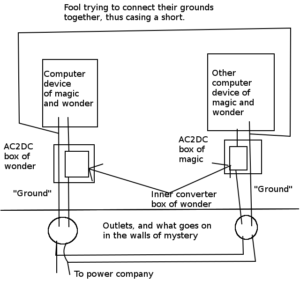When I was growing up I would often read through a bunch of explanations on electricity that always described voltage as “being like electrical pressure”. Now I understand what voltage is, and I still have no clue what that was supposed to mean. Here’s what voltage actually is, but first an analogy:
Electrical charge is sort of like gravity. If you have a positive charge and a negative charge, and hold them some distance away from each other there will be potential energy stored in the distance they are from each other. They want to go to each other, to hold that charge in her arms and say “I love you” before they kiss and the credits role, but sadly the charges cannot meet as cruel fate (i.e. me trying to explain something) is holding them back, but as soon as I let go then all of that potential energy will become kinetic energy as they smash into each other.
Since charge is like gravity, we can use gravity as an analogy for things. If you have a ball that you’re holding in the air then the ball “wants” to go down. The ball has potential energy which is equal to its weight times the height it is at. We can describe the potential for potential energy from gravity at any point in the universe by multiplying the pull of gravity at that point by that points height.
On Mars there’s some point off the ground where you could have precisely: a lot of energy if you were to drop a bowling ball from that height, but you’d have a lot less energy if it was a tennis ball. What I’m talking about is a number that you multiply by the mass of the object in question to get the amount of potential energy it would have if it was held at that point, which is a great way of measuring how dead you would be if you fell from that point. This hypothetical measurement could be taken at any point around any planet.
Why is this relevant? Because we have this exact sort of thing with charge. It’s called “voltage”. Voltage is the amount of potential energy at a point per the amount of charge you could put at that point.
Five volts is equal to five joules of energy for every coulomb you could put there.
Now that I’ve explained that it’s time to introduce you to Mr. Multimeter:

This is Mr. Multimeter. As you can see he has googly eyes because of course he does. Mr. Multimeter has two wires that come off of him. One of these wires is black, and the other is red. Mr. Multimeter can measure the voltage between these two wires. Let that sink in for a second. That might sound like it doesn’t make sense, but consider this:
If we have a hot air balloon that’s a kilometer up, then it’s a kilometer up from the ground. That’s what people mean when they say “5000 feet in the air”. They are measuring feat from the ground and not the center of the Earth. In other words: height is relative. Much the same voltage is relative.
Mr. Multimeter measures voltage from the “ground” (i.e. the black wire) to whatever voltage is at the red wire.
When a circuit makes “5 volts” at one of its outputs it makes it 5 volts from the ground. If two circuits don’t have the same “ground” (i.e. they are at different “heights”) then 5 volts to one circuit is a different voltage to another circuit; however hooking their grounds together makes them the same ground.
That said here’s a word of warning: be careful about hooking the grounds together of two things that both plug into a wall for energy. Often the ground of one device can be traced directly back to one of the metal prongs on the plug that goes into the wall.
Here’s a crudely drawn illustration made with professional image editing software to help explain:

Most devices that the normals use don’t connect their “grounds”. As such many of the AC to DC converters they use just hook the ground of the device directly up to the outlet. So if two grounds are connected for two things that plug into a wall then you might short out the electrical outlet.